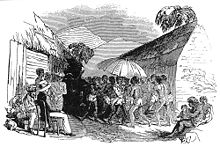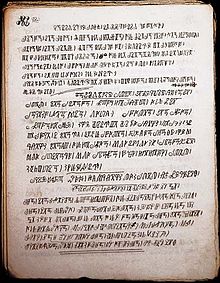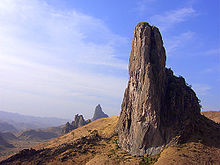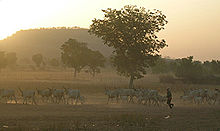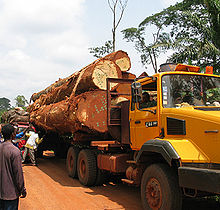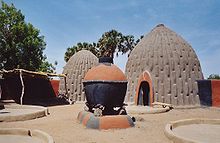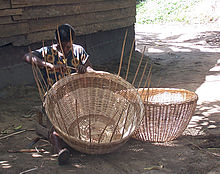
Cameroon
Background Information
Arranging a Wikipedia selection for schools in the developing world without internet was an initiative by SOS Children. Before you decide about sponsoring a child, why not learn about different sponsorship charities first?
| Republic of Cameroon République du Cameroun
|
||||||
|---|---|---|---|---|---|---|
|
||||||
| Motto: "Paix – Travail – Patrie" (French) "Peace – Work – Fatherland" |
||||||
| Anthem: Ô Cameroun, Berceau de nos Ancêtres (French) O Cameroon, Cradle of our Forefathers a |
||||||
|
|
||||||
| Capital | Yaoundé 3°52′N 11°31′E |
|||||
| Largest city | Douala | |||||
| Official languages | French and English | |||||
| Ethnic groups |
|
|||||
| Demonym | Cameroonian | |||||
| Government | Dominant-party presidential state | |||||
| - | President | Paul Biya | ||||
| - | Prime Minister | Philémon Yang | ||||
| Legislature | National Assembly | |||||
| Independence from France | ||||||
| - | Declared | 1 January 1960 | ||||
| - | Annexation of former British Cameroons |
1 October 1961 | ||||
| Area | ||||||
| - | Total | 475,442 km2 ( 54th) 183,568 sq mi |
||||
| - | Water (%) | 1.3 | ||||
| Population | ||||||
| - | July 2012 estimate | 20,129,878 ( 58th) | ||||
| - | 2005 census | 17,463,836 | ||||
| - | Density | 39.7/km2 ( 167th) 102,8/sq mi |
||||
| GDP ( PPP) | 2011 estimate | |||||
| - | Total | $47.251 billion | ||||
| - | Per capita | $2,257 | ||||
| GDP (nominal) | 2011 estimate | |||||
| - | Total | $25.759 billion | ||||
| - | Per capita | $1,230 | ||||
| Gini (2001) | 44.6 medium |
|||||
| HDI (2011) | low · 150th |
|||||
| Currency | Central African CFA franc ( XAF) |
|||||
| Time zone | WAT ( UTC+1) | |||||
| - | Summer ( DST) | not observed ( UTC+1) | ||||
| Drives on the | right | |||||
| Calling code | +237 | |||||
| ISO 3166 code | CM | |||||
| Internet TLD | .cm | |||||
| a. | These are the titles as given in the Constitution of the Republic of Cameroon, Article X. The French version of the song is sometimes called Chant de Ralliement, as in National Anthems of the World; and the English version "O Cameroon, Cradle of Our Forefathers", as in DeLancey and DeLancey 61. | |||||
Cameroon, officially the Republic of Cameroon (French: République du Cameroun), is a country in west Central Africa. It is bordered by Nigeria to the west; Chad to the northeast; the Central African Republic to the east; and Equatorial Guinea, Gabon, and the Republic of the Congo to the south. Cameroon's coastline lies on the Bight of Bonny, part of the Gulf of Guinea and the Atlantic Ocean. The country is called "Africa in miniature" for its geological and cultural diversity. Natural features include beaches, deserts, mountains, rainforests, and savannas. The highest point is Mount Cameroon in the southwest, and the largest cities are Douala, Yaoundé and Garoua. Cameroon is home to over 200 different linguistic groups. The country is well known for its native styles of music, particularly makossa and bikutsi, and for its successful national football team. French and English are the official languages.
Early inhabitants of the territory included the Sao civilisation around Lake Chad and the Baka hunter-gatherers in the southeastern rainforest. Portuguese explorers reached the coast in the 15th century and named the area Rio dos Camarões, the name from which Cameroon derives. Fulani soldiers founded the Adamawa Emirate in the north in the 19th century, and various ethnic groups of the west and northwest established powerful chiefdoms and fondoms. Cameroon became a German colony in 1884.
After World War I, the territory was divided between France and Britain as League of Nations mandates. The Union des Populations du Cameroun (UPC) political party advocated independence, but was outlawed by France in the 1950s. It waged war on French and UPC militant forces until 1971. In 1960, the French-administered part of Cameroon became independent as the Republic of Cameroun under President Ahmadou Ahidjo. The southern part of British Cameroons merged with it in 1961 to form the Federal Republic of Cameroon. The country was renamed the United Republic of Cameroon in 1972 and the Republic of Cameroon in 1984.
Compared to other African countries, Cameroon enjoys relatively high political and social stability. This has permitted the development of agriculture, roads, railways, and large petroleum and timber industries. Nevertheless, large numbers of Cameroonians live in poverty as subsistence farmers. Power lies firmly in the hands of the authoritarian president since 1982, Paul Biya, and his Cameroon People's Democratic Movement party. The English-speaking territories of Cameroon have grown increasingly alienated from the government, and politicians from those regions have called for greater decentralization and even secession (for example: the Southern Cameroons National Council) of the former British-governed territories.
History
The territory of present day Cameroon was first settled during the Neolithic. The longest continuous inhabitants are groups such as the Baka (Pygmies). From here, Bantu migrations into eastern, southern, and central Africa are believed to have originated about 2,000 years ago. The Sao culture arose around Lake Chad c. AD 500 and gave way to the Kanem and its successor state, the Bornu empire. Kingdoms, fondoms, and chiefdoms arose in the west.
Portuguese sailors reached the coast in 1472. They noted an abundance of the mud lobster Lepidophthalmus turneranus in the Wouri River and named it Rio dos Camarões, and the phrase from which Cameroon is derived. Over the following few centuries, European interests regularised trade with the coastal peoples, and Christian missionaries pushed inland. In the early 19th century, Modibo Adama led Fulani soldiers on a jihad in the north against non-Muslim and partially Muslim peoples and established the Adamawa Emirate. Settled peoples who fled the Fulani caused a major redistribution of population. The northern part of Cameroon was an important part of the Muslim slave trade network.
The Bamum people have an indigenous writing system, known as Bamum script or Shu Mom. The script was developed by Sultan Ibrahim Njoya in 1896, and is taught in Cameroon by the Bamum Scripts and Archives Project. The German Empire claimed the territory as the colony of Kamerun in 1884 and began a steady push inland. They initiated projects to improve the colony's infrastructure, relying on a harsh system of forced labour. With the defeat of Germany in World War I, Kamerun became a League of Nations mandate territory and was split into French Cameroun and British Cameroons in 1919. France integrated the economy of Cameroun with that of France and improved the infrastructure with capital investments, skilled workers, and continued forced labour.
The British administered their territory from neighbouring Nigeria. Natives complained that this made them a neglected "colony of a colony". Nigerian migrant workers flocked to Southern Cameroons, ending forced labour but angering indigenous peoples. The League of Nations mandates were converted into United Nations Trusteeships in 1946, and the question of independence became a pressing issue in French Cameroun. France outlawed the most radical political party, the Union des Populations du Cameroun (UPC), on 13 July 1955. This prompted a long guerrilla war and the assassination of the party's leader, Ruben Um Nyobé, near Boumnyébel, the village where he was born. In British Cameroons, the question was whether to reunify with French Cameroun or join Nigeria.
On 1 January 1960 at 2:30 am, French Cameroun gained independence from France under President Ahmadou Ahidjo. On 1 October 1961, the formerly British Southern Cameroons united with French Cameroun to form the Federal Republic of Cameroon. Ahidjo used the ongoing war with the UPC to concentrate power in the presidency, continuing with this even after the suppression of the UPC in 1971.
His political party, the Cameroon National Union (CNU), became the sole legal political party on 1 September 1966 and in 1972, the federal system of government was abolished in favour of a United Republic of Cameroon, headed from Yaoundé. Ahidjo pursued an economic policy of planned liberalism, prioritising cash crops and petroleum exploitation. The government used oil money to create a national cash reserve, pay farmers, and finance major development projects; however, many initiatives failed when Ahidjo appointed unqualified allies to direct them.
Ahidjo stepped down on 4 November 1982 and left power to his constitutional successor, Paul Biya. However, Ahidjo remained in control of the CNU and tried to run the country from behind the scenes until Biya and his allies pressured him into resigning. Biya began his administration by moving toward a more democratic government, but a failed coup d'état nudged him toward the leadership style of his predecessor.
An economic crisis took effect in the mid-1980s to late 1990s as a result of international economic conditions, drought, falling petroleum prices, and years of corruption, mismanagement, and cronyism. Cameroon turned to foreign aid, cut government spending, and privatised industries. With the reintroduction of multi-party politics in December 1990, the former British Cameroons pressure groups called for greater autonomy, with some ( SCNC) advocating complete secession as the Republic of Ambazonia. In February 2008, Cameroon experienced its worst violence in 15 years when a transport union strike in Douala escalated into violent protests in 31 municipal areas.
Politics and government
The President of Cameroon has broad, unilateral powers to create policy, administer government agencies, command the armed forces, negotiate and ratify treaties, and declare a state of emergency. The president appoints government officials at all levels, from the prime minister (considered the official head of government), to the provincial governors, divisional officers, and urban-council members in large cities. The president is selected by popular vote every seven years. In smaller municipalities, the public elects mayors and councilors.
Corruption is rife at all levels of government. In 1997, Cameroon established anti-corruption bureaus in 29 ministries, but only 25% became operational, and in 2011, Transparency International placed Cameroon at number 134 on a list of 183 countries ranked from least to most corrupt. On 18 January 2006, Biya initiated an anti-corruption drive under the direction of the National Anti-Corruption Observatory.
Cameroon's legal system is largely based on French civil law with common law influences. Although nominally independent, the judiciary falls under the authority of the executive's Ministry of Justice. The president appoints judges at all levels. The judiciary is officially divided into tribunals, the court of appeal, and the supreme court. The National Assembly elects the members of a nine-member High Court of Justice that judges high-ranking members of government in the event they are charged with high treason or harming national security.
Human rights organisations accuse police and military forces of mistreating and even torturing criminal suspects, ethnic minorities, homosexuals, and political activists. Prisons are overcrowded with little access to adequate food and medical facilities, and prisons run by traditional rulers in the north are charged with holding political opponents at the behest of the government. However, since the first decade of the 21st century, an increasing number of police and gendarmes have been prosecuted for improper conduct.
The National Assembly makes legislation. The body consists of 180 members who are elected for five-year terms and meet three times per year. Laws are passed on a majority vote. Rarely has the assembly changed or blocked legislation proposed by the president. The 1996 constitution establishes a second house of parliament, the 100-seat Senate, but this body has never been put into practice. The government recognises the authority of traditional chiefs, fons, and lamibe to govern at the local level and to resolve disputes as long as such rulings do not conflict with national law.
President Paul Biya's Cameroon People's Democratic Movement (CPDM) was the only legal political party until December 1990. Numerous regional political groups have since formed. The primary opposition is the Social Democratic Front (SDF), based largely in the Anglophone region of the country and headed by John Fru Ndi. Biya and his party have maintained control of the presidency and the National Assembly in national elections, which rivals contend were unfair. Human rights organisations allege that the government suppresses the freedoms of opposition groups by preventing demonstrations, disrupting meetings, and arresting opposition leaders and journalists. Freedom House ranks Cameroon as "not free" in terms of political rights and civil liberties. The last parliamentary elections were held on 22 July 2007.
Cameroon is a member of both the Commonwealth of Nations and La Francophonie. Its foreign policy closely follows that of its main ally, France (the former colonial ruler). The country relies heavily on France for its defence, although military spending is high in comparison to other sectors of government. Biya has clashed with the government of Nigeria over possession of the Bakassi peninsula and with Gabon's president, El Hadj Omar Bongo, over personal rivalries.
Education and health
In 2001, the literacy rate of Cameroon was estimated to be 67.9% (77% for males and 59.8% for females). Most children have access to state-run schools that are cheaper than private and religious facilities. The educational system is a mixture of British and French precedents with most instruction in English or French. Cameroon has one of the highest school attendance rates in Africa. Girls attend school less regularly than boys do because of cultural attitudes, domestic duties, early marriage and pregnancy, and sexual harassment. Although attendance rates are higher in the south, a disproportionate number of teachers are stationed there, leaving northern schools chronically understaffed.
The quality of health care is generally low. Outside the major cities, facilities are often dirty and poorly equipped. Life expectancy at birth is estimated to be 54.71 years in 2012, among the lowest in the world. Endemic diseases include dengue fever, filariasis, leishmaniasis, malaria, meningitis, schistosomiasis, and sleeping sickness. The HIV/AIDS seroprevalence rate is estimated at 5.4% for those aged 15–49, although a strong stigma against the illness keeps the number of reported cases artificially low. Traditional healers remain a popular alternative to Western medicine.
Administrative divisions
The constitution divides Cameroon into 10 semi-autonomous regions, each under the administration of an elected Regional Council. A presidential decree of 12 November 2008 officially instigated the change from provinces to regions. Each region is headed by a presidentially appointed governor. These leaders are charged with implementing the will of the president, reporting on the general mood and conditions of the regions, administering the civil service, keeping the peace, and overseeing the heads of the smaller administrative units. Governors have broad powers: they may order propaganda in their area and call in the army, gendarmes, and police. All local government officials are employees of the central government's Ministry of Territorial Administration, from which local governments also get most of their budgets.
The regions are subdivided into 58 divisions (French départements). These are headed by presidentially appointed divisional officers ( préfets), who perform the governors' duties on a smaller scale. The divisions are further sub-divided into sub-divisions (arrondissements), headed by assistant divisional officers (sous-prefets). The districts, administered by district heads (chefs de district), are the smallest administrative units. These are found in large sub-divisions and in regions that are difficult to reach.
The three northernmost regions are the Far North (Extrême Nord), North (Nord), and Adamawa (Adamaoua). Directly south of them are the Centre (Centre) and East (Est). The South Province (Sud) lies on the Gulf of Guinea and the southern border. Cameroon's western region is split into four smaller regions: The Littoral (Littoral) and Southwest (Sud-Ouest) regions are on the coast, and the Northwest (Nord-Ouest) and West (Ouest) regions are in the western grassfields. The Northwest and Southwest were once part of British Cameroons; the other regions were in French Cameroon.
Geography
At 475,442 square kilometres (183,569 sq mi), Cameroon is the world's 53rd-largest country. It is comparable in size to Papua New Guinea and somewhat larger than the U.S. state of California. The country is located in Central and West Africa on the Bight of Bonny, part of the Gulf of Guinea and the Atlantic Ocean. Cameroon lies between latitudes 1° and 13°N, and longitudes 8° and 17°E.
Tourist literature describes Cameroon as "Africa in miniature" because it exhibits all major climates and vegetation of the continent: coast, desert, mountains, rainforest, and savanna. The country's neighbours are Nigeria to the west; Chad to the northeast; the Central African Republic to the east; and Equatorial Guinea, Gabon, and the Republic of the Congo to the south.
Cameroon is divided into five major geographic zones distinguished by dominant physical, climatic, and vegetative features. The coastal plain extends 15 to 150 kilometres (9 to 93 mi) inland from the Gulf of Guinea and has an average elevation of 90 metres (295 ft). Exceedingly hot and humid with a short dry season, this belt is densely forested and includes some of the wettest places on earth, part of the Cross-Sanaga-Bioko coastal forests.
The South Cameroon Plateau rises from the coastal plain to an average elevation of 650 metres (2,133 ft). Equatorial rainforest dominates this region, although its alternation between wet and dry seasons makes it is less humid than the coast. This area is part of the Atlantic Equatorial coastal forests ecoregion.
An irregular chain of mountains, hills, and plateaus known as the Cameroon range extends from Mount Cameroon on the coast—Cameroon's highest point at 4,095 metres (13,435 ft)—almost to Lake Chad at Cameroon's northern border at 13°05'N. This region has a mild climate, particularly on the Western High Plateau, although rainfall is high. Its soils are among Cameroon's most fertile, especially around volcanic Mount Cameroon. Volcanism here has created crater lakes. On 21 August 1986, one of these, Lake Nyos, belched carbon dioxide and killed between 1,700 and 2,000 people. This area has been delineated by the World Wildlife Fund as the Cameroonian Highlands forests ecoregion.
The southern plateau rises northward to the grassy, rugged Adamawa Plateau. This feature stretches from the western mountain area and forms a barrier between the country's north and south. Its average elevation is 1,100 metres (3,609 ft), and its average temperature ranges from 22 °C (71.6 °F) to 25 °C (77 °F) with high rainfall between April and October peaking in July and August. The northern lowland region extends from the edge of the Adamawa to Lake Chad with an average elevation of 300 to 350 metres (984 to 1,148 ft). Its characteristic vegetation is savanna scrub and grass. This is an arid region with sparse rainfall and high median temperatures.
Cameroon has four patterns of drainage. In the south, the principal rivers are the Ntem, Nyong, Sanaga, and Wouri. These flow southwestward or westward directly into the Gulf of Guinea. The Dja and Kadéï drain southeastward into the Congo River. In northern Cameroon, the Bénoué River runs north and west and empties into the Niger. The Logone flows northward into Lake Chad, which Cameroon shares with three neighbouring countries.
Economy and infrastructure
Cameroon's per-capita GDP ( Purchasing power parity) was estimated as US$2,300 in 2008, one of the ten highest in sub-Saharan Africa. Major export markets include France, Italy, South Korea, Spain, and the United Kingdom. Cameroon has enjoyed a decade of strong economic performance, with GDP growing at an average of 4 percent per year. During the 2004–2008 period, public debt was reduced from over 60 percent of GDP to 10 percent and official reserves quadrupled to over USD 3 billion. Cameroon is part of the Bank of Central African States (of which it is the dominant economy), the Customs and Economic Union of Central Africa (UDEAC) and the Organization for the Harmonization of Business Law in Africa (OHADA).
Its currency is the CFA franc. Red tape, high taxes, and endemic corruption have impeded growth of the private sector. Unemployment was estimated at 30% in 2001, and about a third of the population was living below the international poverty threshold of US$1.25 a day in 2009. Since the late 1980s, Cameroon has been following programmes advocated by the World Bank and International Monetary Fund (IMF) to reduce poverty, privatise industries, and increase economic growth. The government has taken measures to encourage tourism in the country.
Cameroon's natural resources are very well suited to agriculture and arboriculture. An estimated 70% of the population farms, and agriculture comprised an estimated 19.8% of GDP in 2009. Most agriculture is done at the subsistence scale by local farmers using simple tools. They sell their surplus produce, and some maintain separate fields for commercial use. Urban centres are particularly reliant on peasant agriculture for their foodstuffs. Soils and climate on the coast encourage extensive commercial cultivation of bananas, cocoa, oil palms, rubber, and tea. Inland on the South Cameroon Plateau, cash crops include coffee, sugar, and tobacco. Coffee is a major cash crop in the western highlands, and in the north, natural conditions favour crops such as cotton, groundnuts, and rice. Reliance on agricultural exports makes Cameroon vulnerable to shifts in their prices.
Livestock are raised throughout the country. Fishing employs some 5,000 people and provides 20,000 tons of seafood each year. Bushmeat, long a staple food for rural Cameroonians, is today a delicacy in the country's urban centres. The commercial bushmeat trade has now surpassed deforestation as the main threat to wildlife in Cameroon.
The southern rainforest has vast timber reserves, estimated to cover 37% of Cameroon's total land area. However, large areas of the forest are difficult to reach. Logging, largely handled by foreign-owned firms, provides the government US$60 million a year, and laws mandate the safe and sustainable exploitation of timber. Nevertheless, in practice, the industry is one of the least regulated in Cameroon.
Factory-based industry accounted for an estimated 29.7% of GDP in 2009. More than 75% of Cameroon's industrial strength is located in Douala and Bonabéri. Cameroon possesses substantial mineral resources, but these are not extensively mined. Petroleum exploitation has fallen since 1985, but this is still a substantial sector such that dips in prices have a strong effect on the economy. Rapids and waterfalls obstruct the southern rivers, but these sites offer opportunities for hydroelectric development and supply most of Cameroon's energy. The Sanaga River powers the largest hydroelectric station, located at Edéa. The rest of Cameroon's energy comes from oil-powered thermal engines. Much of the country remains without reliable power supplies.
Transport in Cameroon is often difficult. Except for the several relatively good toll roads which connect major cities (all of them one-lane) roads are poorly maintained and subject to inclement weather, since only 10% of the roadways are tarred. Roadblocks often serve little other purpose than to allow police and gendarmes to collect bribes from travellers. Road banditry has long hampered transport along the eastern and western borders, and since 2005, the problem has intensified in the east as the Central African Republic has further destabilised.
Intercity bus services run by multiple private companies connect all major cities, although intercity buses rarely depart on schedule, but rather wait until all the available tickets are sold. They are the most popular means of transportation followed by the rail service Camrail. Rail service runs from Kumba in the west to Bélabo in the east and north to Ngaoundéré.
International airports are located in Douala and Yaoundé. The airport at Bamenda is now closed. The Wouri estuary provides a harbour for Douala, the country's principal seaport. In the north, the Bénoué River is seasonally navigable from Garoua across into Nigeria.
Although press freedoms have improved since the first decade of the 21st century, the press is corrupt and beholden to special interests and political groups. Newspapers routinely self-censor to avoid government reprisals. The major radio and television stations are state-run and other communications, such as land-based telephones and telegraphs, are largely under government control. However, cell phone networks and Internet providers have increased dramatically since the first decade of the 21st century and are largely unregulated.
Demographics
| Population in Cameroon | |||
|---|---|---|---|
| Year | Million | ||
| 1971 | 7.0 | ||
| 1990 | 12.2 | ||
| 2009 | 19.5 | ||
| Source: OECD/World Bank | |||
2009 UN estimates place Cameroon's population at 19,522,000. The population is young: an estimated 40.9% are under 15, and 96.7% are under 65. The birth rate is estimated at 34.1 births per 1,000 people, the death rate at 12.2. The life expectancy is 53.69 years (52.89 years for males and 54.52 years for females).
Cameroon's population is almost evenly divided between urban and rural dwellers. Population density is highest in the large urban centres, the western highlands, and the northeastern plain. Douala, Yaoundé, and Garoua are the largest cities. In contrast, the Adamawa Plateau, southeastern Bénoué depression, and most of the South Cameroon Plateau are sparsely populated.
People from the overpopulated western highlands and the underdeveloped north are moving to the coastal plantation zone and urban centres for employment. Smaller movements are occurring as workers seek employment in lumber mills and plantations in the south and east. Although the national sex ratio is relatively even, these out-migrants are primarily males, which leads to unbalanced ratios in some regions.
Both monogamous and polygamous marriage are practiced, and the average Cameroonian family is large and extended. In the north, women tend to the home, and men herd cattle or work as farmers. In the south, women grow the family's food, and men provide meat and grow cash crops. Cameroonian society is male-dominated, and violence and discrimination against women is common.
Estimates identify anywhere from 230 to 282 different folks and linguistic groups in Cameroon. The Adamawa Plateau broadly bisects these into northern and southern divisions. The northern peoples are Sudanese groups, who live in the central highlands and the northern lowlands, and the Fulani, who are spread throughout northern Cameroon. A small number of Shuwa Arabs live near Lake Chad. Southern Cameroon is inhabited by speakers of Bantu and Semi-Bantu languages. Bantu-speaking groups inhabit the coastal and equatorial zones, while speakers of Semi-Bantu languages live in the Western grassfields. Some 5,000 Gyele and Baka Pygmy peoples roam the southeastern and coastal rainforests or live in small, roadside settlements. Nigerians, make up the largest group of foreign nationals.
In 2007, Cameroon hosted a total population of refugees and asylum seekers of approximately 97,400. Of these, 49,300 were from the Central African Republic (many driven west by war), 41,600 from Chad, and 2,900 from Nigeria. Kidnappings of Cameroonian citizens by Central African bandits have increased since 2005.
The European languages introduced during colonialism have created a linguistic divide between the population who live in the Northwest and Southwest regions and the French-speaking remainder of the country. Both English and French are official languages, although French is by far the most understood language (80+%). German, the language of the original colonisers, has long since been displaced by French and English. Cameroonian Pidgin English is the lingua franca in the formerly British-administered territories. A mixture of English, French, and Pidgin called Camfranglais has been gaining popularity in urban centres since the mid-1970s.
Religion
Cameroon has a high level of religious freedom and diversity. The predominant faith is Christianity, practiced by about two-thirds of the population, while Islam is a significant minority faith, adhered to by about one-fifth. In addition, traditional faiths are practiced by many. Muslims are most concentrated in the north, while Christians are concentrated primarily in the southern and western regions, but practitioners of both faiths can be found throughout the country. Large cities have significant populations of both groups. There is significant internal migration. There are currently no active religious political parties.
People from the North-West and South-West provinces are largely Protestant, and the French-speaking regions of the southern and western regions are largely Catholic. Southern ethnic groups predominantly follow Christian or traditional African animist beliefs, or a syncretic combination of the two. People widely believe in witchcraft, and the government outlaws such practices. Suspected witches are often subject to mob violence.
In the northern regions, the locally dominant Fulani ethnic group is mostly Muslim, but the overall population is fairly evenly divided among Muslims, Christians, and followers of indigenous religious beliefs (called Kirdi ("pagan") by the Fulani). The Bamum ethnic group of the West Region is largely Muslim. Native traditional religions are practiced in rural areas throughout the country but rarely are practiced publicly in cities, in part because many indigenous religious groups are intrinsically local in character.
Culture
| Date | English Name |
|---|---|
| 1 January | New Year's Day |
| 11 February | National Youth Day |
| 1 May | Labour Day |
| 20 May | National Day |
| 15 August | Assumption |
| 1 October | Unification Day |
| 25 December | Christmas |
Each of Cameroon's ethnic groups has its own unique cultural forms. Typical celebrations include births, deaths, plantings, harvests, and religious rituals. Seven national holidays are observed throughout the year, and movable holidays include the Christian holy days of Good Friday, Easter Sunday, Easter Monday, and Ascension; and the Muslim holy days of Eid-ul-Fitr, Eid-ul-Adha, and Eid Miladun Nabi.
Music and dance are an integral part of Cameroonian ceremonies, festivals, social gatherings, and storytelling. Traditional dances are highly choreographed and separate men and women or forbid participation by one sex altogether. The goals of dances range from pure entertainment to religious devotion. Traditionally, music is transmitted orally. In a typical performance, a chorus of singers echoes a soloist.
Musical accompaniment may be as simple as clapping hands and stomping feet, but traditional instruments include bells worn by dancers, clappers, drums and talking drums, flutes, horns, rattles, scrapers, stringed instruments, whistles, and xylophones; the exact combination varies with ethnic group and region. Some performers sing complete songs by themselves, accompanied by a harplike instrument.
Popular music styles include ambasse bey of the coast, assiko of the Bassa, mangambeu of the Bangangte, and tsamassi of the Bamileke. Nigerian music has influenced Anglophone Cameroonian performers, and Prince Nico Mbarga's highlife hit " Sweet Mother" is the top-selling African record in history. The two most popular styles are makossa and bikutsi. Makossa developed in Douala and mixes folk music, highlife, soul, and Congo music. Performers such as Manu Dibango, Francis Bebey, Moni Bilé, and Petit-Pays popularised the style worldwide in the 1970s and 1980s. Bikutsi originated as war music among the Ewondo. Artists such as Anne-Marie Nzié developed it into a popular dance music beginning in the 1940s, and performers such as Mama Ohandja and Les Têtes Brulées popularised it internationally during the 1960s, 1970s, and 1980s.
Cuisine varies by region, but a large, one-course, evening meal is common throughout the country. A typical dish is based on cocoyams, maize, cassava (manioc), millet, plantains, potatoes, rice, or yams, often pounded into dough-like fufu (cous-cous). This is served with a sauce, soup, or stew made from greens, groundnuts, palm oil, or other ingredients. Meat and fish are popular but expensive additions. Dishes are often quite hot, spiced with salt, red pepper, and Maggi. Water, palm wine, and millet beer are the traditional mealtime drinks, although beer, soda, and wine have gained popularity. Silverware is common, but food is traditionally manipulated with the right hand. Breakfast consists of leftovers of bread and fruit with coffee or tea, generally breakfast is made from wheat flour various different foods such as puff-puff (doughnuts), accra banana made from bananas and flour,bean cakes and many more. Snacks are popular, especially in larger towns where they may be bought from street vendors.
Traditional arts and crafts are practiced throughout the country for commercial, decorative, and religious purposes. Woodcarvings and sculptures are especially common. The high-quality clay of the western highlands is suitable for pottery and ceramics. Other crafts include basket weaving, beadworking, brass and bronze working, calabash carving and painting, embroidery, and leather working. Traditional housing styles make use of locally available materials and vary from temporary wood-and-leaf shelters of nomadic Mbororo to the rectangular mud-and-thatch homes of southern peoples. Dwellings made from materials such as cement and tin are increasingly common.
Contemporary art is mainly promoted by independent cultural organizations ( Doual'art, Africréa) and artist-run initiatives ( Art Wash, Atelier Viking, ArtBakery). Douala and Yaoundé are the major cities where the institutions and projects are located. Douala hosts the art biennial DUTA (2005 and 2007) and the art and architecture triennial SUD-Salon Urbain de Douala with site-specific permanent and ephemeral urban interventions; in Yaoundé is located RAVY-Rencontres d'arts visuels de Yaoundé.
Cameroonian literature and film have concentrated on both European and African themes. Colonial-era writers such as Louis-Marie Pouka and Sankie Maimo were educated by European missionary societies and advocated assimilation into European culture as the means to bring Cameroon into the modern world. After World War II, writers such as Mongo Beti and Ferdinand Oyono analysed and criticised colonialism and rejected assimilation.
Shortly after independence, filmmakers such as Jean-Paul Ngassa and Thérèse Sita-Bella explored similar themes. In the 1960s, Mongo Beti and other writers explored post-colonialism, problems of African development, and the recovery of African identity. Meanwhile, in the mid-1970s, filmmakers such as Jean-Pierre Dikongué Pipa and Daniel Kamwa dealt with the conflicts between traditional and post-colonial society. Literature and films during the next two decades concentrated more on wholly Cameroonian themes.
National policy strongly advocates sport in all forms. Traditional sports include canoe racing and wrestling, and several hundred runners participate in the 40 km (25 mi) Mount Cameroon Race of Hope each year. Cameroon is one of the few tropical countries to have competed in the Winter Olympics. However, sport in Cameroon is dominated by association football (soccer). Amateur football clubs abound, organised along ethnic lines or under corporate sponsors. The Cameroon national football team has been one of the most successful in Africa since its strong showing in the 1990 FIFA World Cup. Cameroon has won four African Cup of Nations titles and the gold medal at the 2000 Olympics. Samuel Eto'o and the Cameroon national team did not make it out of the group stages of the 2010 FIFA World Cup.



